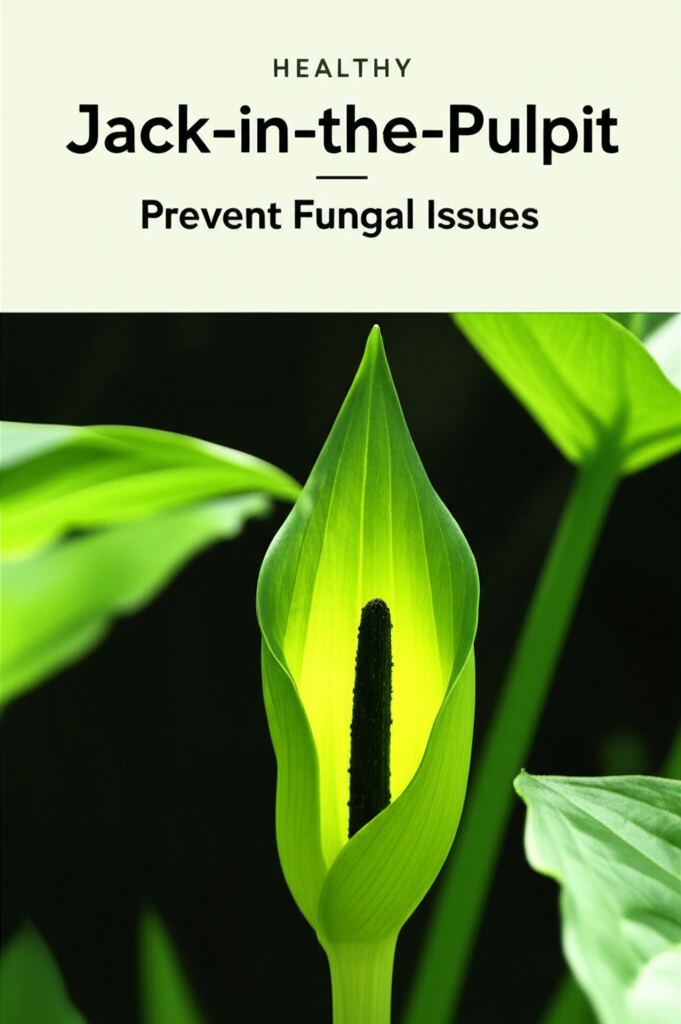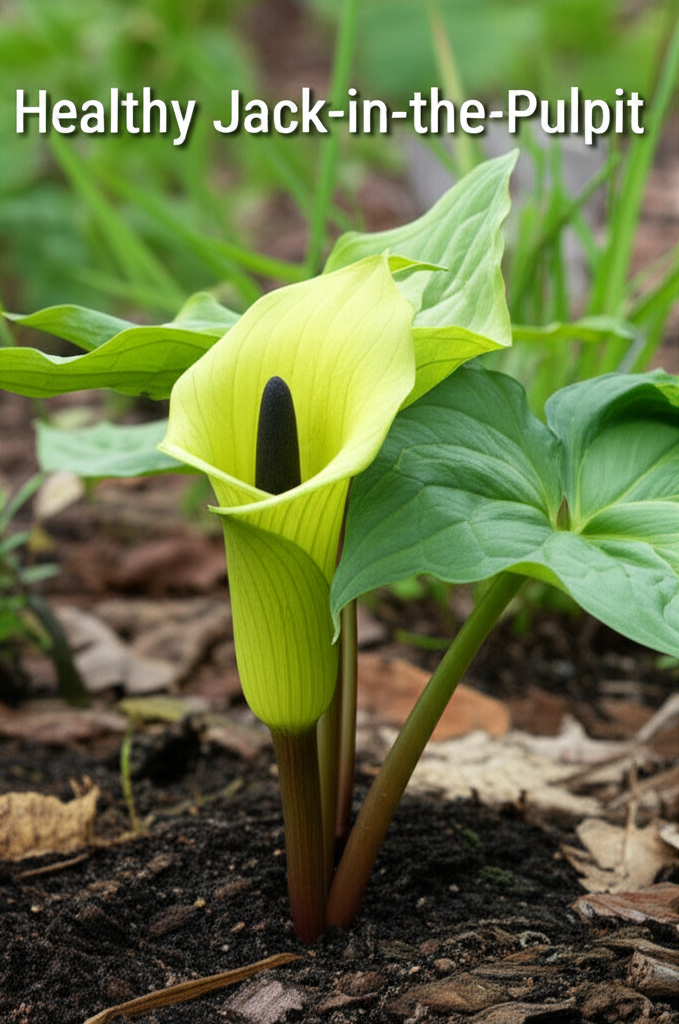The Allure of Jack-in-the-Pulpit and Its Vulnerabilities
Jack-in-the-Pulpit (Arisaema triphyllum) is a captivating woodland perennial, instantly recognizable by its unique spathe and spadix, resembling a preacher in a pulpit. Its striking appearance and ecological significance make it a prized addition to shady, moist garden environments. However, like many native plants, it is susceptible to various fungal diseases that can detract from its beauty and even threaten its survival. Understanding these vulnerabilities and implementing proactive preventative measures is crucial for any gardener hoping to cultivate healthy, thriving Jack-in-the-Pulpit specimens.
Fungal pathogens thrive in specific environmental conditions, often exacerbated by poor air circulation, prolonged leaf wetness, and weakened plant health. These pathogens can manifest in various ways, from unsightly leaf spots and wilting to more systemic infections that can be difficult to eradicate. Fortunately, with a diligent and informed approach, gardeners can significantly reduce the risk of fungal diseases and ensure their Jack-in-the-Pulpits remain a vibrant feature of their native plant gardens.
Common Fungal Diseases Affecting Jack-in-the-Pulpit

Several fungal diseases commonly target Jack-in-the-Pulpit. Identifying these potential threats is the first step in effective prevention.
Leaf Spot Diseases
Leaf spot diseases are perhaps the most common fungal ailments encountered. They are caused by various fungi, including species of Colletotrichum, Septoria, and Guignardia. These diseases typically present as small, irregular spots on the leaves, which can enlarge, merge, and eventually cause leaf yellowing and premature dropping.
- Symptoms: Discolored spots (brown, black, or tan) on leaves, often with defined borders. In severe cases, the spots may coalesce, leading to blighting and defoliation.
- Contributing Factors: High humidity, wet foliage, poor air circulation, and the presence of infected plant debris.
Root Rot
While not exclusively fungal, root rot is frequently initiated or exacerbated by fungal pathogens such as Phytophthora and Pythium species. These water molds thrive in waterlogged soil and can devastate a plant’s root system, leading to stunting, wilting, and eventual death.
- Symptoms: Yellowing leaves, stunted growth, wilting even when the soil is moist, and mushy, discolored roots.
- Contributing Factors: Poorly draining soil, overwatering, and compacted soil.
Anthracnose
Anthracnose is a group of fungal diseases that can affect various parts of the Jack-in-the-Pulpit, including leaves, stems, and even the spathe. Symptoms can range from small, dark spots to larger, irregular lesions that can cause leaf and stem dieback.
- Symptoms: Dark, sunken lesions on leaves and stems, often with concentric rings. In severe cases, it can lead to blossom blight and wilting.
- Contributing Factors: Warm, humid conditions, and prolonged periods of leaf wetness.
Powdery Mildew
Though less common on Jack-in-the-Pulpit than some other woodland plants, powdery mildew can still appear, particularly in conditions of high humidity and poor air circulation. It manifests as a white, powdery growth on the leaf and stem surfaces.
- Symptoms: White, powdery patches on the upper surfaces of leaves and stems.
- Contributing Factors: High humidity, shade, and limited air movement.
Key Facts and Comparison of Common Fungal Diseases
Understanding the nuances of these diseases helps in targeted prevention.
| Disease | Primary Symptoms | Ideal Conditions | Impact on Plant |
|---|---|---|---|
| Leaf Spot Diseases | Discolored spots on leaves, potential defoliation | High humidity, wet foliage, poor air circulation | Reduced photosynthesis, aesthetic damage, premature leaf drop |
| Root Rot | Wilting, yellowing leaves, stunted growth, rotten roots | Waterlogged soil, overwatering, poor drainage | Systemic decline, plant death |
| Anthracnose | Dark lesions on leaves and stems, blight, dieback | Warm, humid conditions, prolonged leaf wetness | Leaf and stem damage, reduced vigor |
| Powdery Mildew | White, powdery growth on leaf surfaces | High humidity, shade, limited air movement | Reduced photosynthesis, aesthetic damage |
Proactive Prevention Strategies
The most effective approach to managing fungal diseases on Jack-in-the-Pulpit is through proactive prevention. This involves creating an environment that is less conducive to fungal pathogen development and ensuring the plant is in robust health.
1. Site Selection and Soil Preparation
The foundation of a healthy Jack-in-the-Pulpit lies in its planting location and the quality of the soil.
- Drainage is Paramount: Jack-in-the-Pulpit thrives in moist, but not waterlogged, conditions. Choose a site that naturally drains well. If your soil is heavy clay, amend it generously with organic matter such as compost, well-rotted leaf mold, or pine bark. This improves aeration and drainage, crucial for preventing root rot.
- Partial to Full Shade: Jack-in-the-Pulpit prefers dappled shade or light shade, mimicking its native woodland habitat. Avoid full sun, which can stress the plant and make it more susceptible to diseases.
- Avoid Overcrowding: Plant Jack-in-the-Pulpit with adequate spacing. This allows for good air circulation around the plants, which is vital for drying foliage quickly and reducing the time pathogens have to infect.
2. Watering Practices
Watering is a critical factor in disease prevention, as prolonged leaf wetness creates an ideal environment for fungal spores to germinate and infect.
- Water at the Base: Whenever possible, water your Jack-in-the-Pulpit at the base of the plant. Avoid overhead watering, which wets the foliage and provides a breeding ground for fungi.
- Water in the Morning: Watering in the morning allows any splashed moisture on the leaves to dry off during the day, minimizing the risk of infection.
- Monitor Soil Moisture: Stick your finger about an inch or two into the soil. If it feels moist, hold off on watering. Allow the soil to dry slightly between waterings. Overwatering is a common mistake that leads to root rot.
3. Mulching for Health and Protection
A layer of organic mulch offers numerous benefits for Jack-in-the-Pulpit health and disease prevention.
- Moisture Regulation: Mulch helps retain soil moisture, reducing the need for frequent watering and preventing the soil from drying out too much.
- Suppression of Pathogens: A good layer of mulch can suppress soil-borne fungal spores from splashing up onto the plant’s foliage during rain or watering.
- Weed Control: Mulch helps suppress weeds, which can compete with your Jack-in-the-Pulpit for resources and potentially harbor pests and diseases.
- Recommended Mulches: Use shredded bark, pine needles, compost, or leaf mold. Apply a 2-3 inch layer around the base of the plant, keeping it a few inches away from the stem to prevent rot.
4. Air Circulation and Pruning
Good air movement is a natural deterrent to many fungal diseases.
- Strategic Planting: As mentioned, adequate spacing is key.
- Remove Debris: After the foliage dies back in the fall, promptly remove all dead plant material. This infected debris can harbor fungal spores that will overwinter and reinfect the plant in the spring. Dispose of it away from your garden.
- Thinning (if necessary): In dense plantings, consider gently thinning out weaker or overcrowded stems to improve air flow.
5. Plant Nutrition and Vigor
A healthy, vigorous plant is far more resilient to disease than a stressed or weak one.
- Amend Soil Annually: Top-dress around your Jack-in-the-Pulpit with compost or other organic matter each spring. This provides essential nutrients and improves soil structure.
- Avoid Over-Fertilizing: While nutrients are important, avoid excessive fertilization, especially with high-nitrogen fertilizers. This can lead to soft, succulent growth that is more attractive to pests and diseases. Focus on building healthy soil.
6. Monitoring and Early Detection
Regularly inspecting your Jack-in-the-Pulpit for any signs of disease is crucial for early intervention.
- Weekly Checks: Make it a habit to walk through your garden and observe your plants. Look for any unusual spots, discoloration, wilting, or powdery growth.
- Immediate Action: If you spot the very first signs of a fungal issue, act swiftly. Often, early intervention can prevent a minor problem from becoming a major infestation.
Steps to Prevent Fungal Diseases: A Practical Approach
Implementing these preventative measures can be systematized for consistent success.
| Step | Action | Rationale | Frequency |
|---|---|---|---|
| 1 | Select a well-draining, shaded location. Amend soil with organic matter if necessary. | Prevents root rot and reduces plant stress. | At planting and annually thereafter. |
| 2 | Water at the base of the plant in the morning. Avoid overhead watering. | Minimizes leaf wetness, discouraging fungal spore germination. | As needed, based on soil moisture. |
| 3 | Apply a 2-3 inch layer of organic mulch around the plant. | Regulates moisture, suppresses soil-borne spores, and controls weeds. | In spring and fall. |
| 4 | Ensure adequate spacing and remove dead plant material in fall. | Promotes air circulation and eliminates overwintering fungal sources. | Ongoing for spacing; annually in fall. |
| 5 | Top-dress with compost annually and avoid excessive fertilization. | Builds plant vigor and resilience. | Annually in spring. |
| 6 | Regularly inspect plants for early signs of disease. | Allows for prompt intervention before problems escalate. | Weekly during the growing season. |
What to Do If You Spot a Fungal Disease
Despite the best preventative efforts, diseases can sometimes take hold. Early detection and the right response are key.
- Identify the Disease: If you see symptoms, try to identify the specific disease. Resources like local extension offices, reputable gardening websites, or experienced local gardeners can be invaluable.
- Remove Infected Material: For leaf spot or anthracnose, immediately prune away and destroy any affected leaves or stems. Do not compost this material.
- Improve Conditions: If you suspect poor air circulation or overwatering is contributing, address these issues immediately. This might involve pruning nearby plants, adjusting your watering schedule, or improving soil drainage.
- Consider Fungicides (Use Sparingly and Responsibly): In cases of severe or persistent fungal infections, a fungicide may be necessary.
Organic Options: Neem oil, copper-based fungicides, or sulfur-based fungicides are often effective and more environmentally friendly.
Synthetic Options: If using synthetic fungicides, choose products specifically labeled for the target disease and plant type.
Application: Always follow label instructions carefully regarding dosage, application timing, and safety precautions. Fungicides are generally most effective when applied preventatively or at the very first sign of disease. Multiple applications may be required according to the product label.
Last Resort: Fungicides should be considered a last resort after other cultural controls have been implemented.
Environmental Considerations and Sustainable Practices
Our approach to gardening should always aim to be as sustainable and environmentally friendly as possible.
- Native Plant Benefits: By cultivating native plants like Jack-in-the-Pulpit, you support local ecosystems and biodiversity. These plants are often naturally adapted to your local climate, requiring less intervention.
- Promoting Beneficial Organisms: Healthy soil rich in organic matter supports a diverse community of microorganisms that can help suppress plant diseases. Avoid the overuse of pesticides and synthetic fertilizers, which can disrupt this delicate balance.
- Composting: Properly managed compost bins can turn garden waste into a valuable soil amendment, closing the loop in your garden’s nutrient cycle.
- Water Conservation: Implementing smart watering practices not only prevents disease but also conserves a precious resource.
Conclusion: A Sanctuary of Health for Your Jack-in-the-Pulpit
Jack-in-the-Pulpit is a truly special plant that deserves our care and attention. By understanding the common fungal diseases it can face and implementing a robust preventative strategy, gardeners can create a healthy sanctuary for these fascinating woodland gems. The key lies in building healthy soil, practicing mindful watering, ensuring good air circulation, and regularly observing your plants. With a proactive and informed approach, you can enjoy the unique beauty of Jack-in-the-Pulpit for years to come, free from the threat of fungal diseases. Remember, a healthy plant is your best defense.


